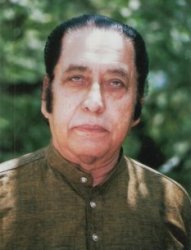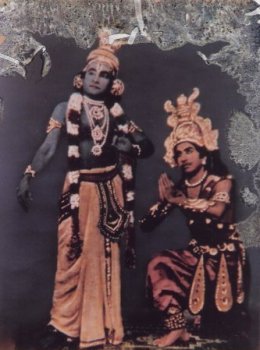 |
  |
 |
  |
Guru Gopalakrishnan no more - Ashish Mohan Khokar e-mail: khokar1960@gmail.com Photos: The Mohan Khokar Dance Collection September 8, 2012  He desired he either pass away on stage, like his guru, the great Gopinath, or in sleep. He did pass away peacefully in his sleep, on Teacher's Day, 5th September 2012 in Chennai. Born on April 9, 1926 in Kodungallur, this scion of Nanthialath and Changaradi tharavads (households) was destined to take to dance. His parents Nanthialath Madhava Menon and Changaradi Ammalu Amma let him pursue his passion, which was sparked by seeing T.R. Sundaram's film 'Balan' in 1938. He desired to learn Kathakali from the masters but chance brought him to Madras to be at the Gemini Studios and come in contact with the legendary Guru Gopinath, then based in Madras. In 1946, he joined the Natana Niketan dance school. Madras was then a very happening place for dance and films and many fortunes and fame were being made. Guru Gopinath was choreographing and dancing for many films, thus Gopalakrishnan got a firm foothold in the dance and film world. He was promoted to become lead dancer in Guru Gopinath's troupe. The stay in Madras made Guru Gopalakrishnan aware of several aspects of dance direction, films, sets and all related arts and crafts. This he put to good use in the first big break in the Drum Dance sequence of the famous film Chandralekha. Though many dancers and choreographers talk of this film and sequence and some also take credit (!), Guru Gopalakrishnan has documentary proof of his participation. This movie is a classic, the Drum Dance sequence took 6 months to shoot and the film itself cost 30 lakhs then! A princely sum when a full thali meal those days cost just 60 paise! Gemini Studios, where he was employed as full time dancer, was the first Tamil studio to try and distribute the film on pan-Indian basis. Even my mother took me to see this classic in the late sixties when it was still running! SS Vasan had done the direction and Papanasam Sivan, lyrics and the music was done by Saluri Rajeshwar Rao. That was the golden era of dance in Tamil films and many names were made in that period. Guru Gopalakrishnan became a popular and sought after dancing star and participated in many Tamil, Telugu, Kannada, Malayalam, Hindi and even Sinhalese films.  Guru Gopalakrishnan  Guru Gopalakrishnan with Guru Gopinath In between, for brief periods in 1948, he proceeded to Kottakal with full blessings of Guru Gopinath, to learn extensively at the PSV Natya Sangam and here he came under the guidance of Guru Vazhenkada Kunju Nair, under whom he completed his rangapravesam. In 1953, he was chosen as member of a prestigious cultural delegation to China and had the opportunity to meet Mao Tse Tung and Chou En Lai, no less. Recounting his meeting, Guru Gopalakrishnan took delight in the handshake the great leader gave him. Ustad Vilayat Khan and Hirabai Barodekar were other members of the delegation. Upon return, they performed for Pt. Nehru in Delhi with Guru Gopinath as Krishna and Gopal as Arjuna in 'Geethopadesam.' Next year in 1954, the first Malayalam film 'Neelakuyil' was made. Whereas earlier films were remakes of Tamil ones, this one was made for and by Malayalees. It won the President's Silver Medal at the national film festival. Guru Gopalakrishnan had the distinction of directing dances in this film. From here on, he directed and contributed to several films like Sitaramakalyanam, Jeevithanouka, Amma. In 1956, he established his own troupe named Bharatiya Ballet troupe with MB Sreenivasan as his music director. Those days it was a trend to have large dance groups that also travelled all over. Among the orchestra was harmonium player RK Shekhar, father of Dileep, now also known as AR Rahman, the iconic music talent-composer today. In 1963, he married Kusum, who was born in Mehsana in Gujarat on 28th Sept 1943, although hailing from his native Kodungallur. She was a student of Kalamandalam and together they continued their activities with their troupe and films, while also conducting classes in Madras. They had a record series of performance concerts for 100 days in 1968 at the Navaratna Theatres (Sapphire group). In 1964 they were blessed with son Vinod, whose wife is Srilatha, a well-known Bharatanatyam talent trained under the reputed Dhananjayans. A daughter, Apsara, was born in 1966, now married and settled in Malaysia. She married Ramgopal, whose parents are famous dancers Sivadas and Vatsala. After two children, the dancing duo sensibly decided to travel less and settle down and an opportunity came to teach dance at the New Era School in Panchagani which they took and stuck to for 22 years. This was the reason they faded from active national dance scene, though they contributed to building young India and sensibilities to dance art. They created a unique method of 'Drishyakatha' narrative, a blend of Kerala Natanam, free dance style and folk forms, so children could absorb easily. As dance educators, their roles cannot be underestimated. In 1994, they returned to their native Kerala and for past few years settled in Madras. No national award has come their way because they worked quietly. They have written fine books on their form and the recent book - Kerala Natanam - is an authentic and authoritative source and slice of the dance history and heritage of the form and also platforms important personages. Their serving the art of Kerala Natanam has also made them the authentic and exclusive representative of the style, now done by very few. In them, the history of the form stayed. Guru Gopalakrishnan may be dead but long live his art!  Ashish
Mohan Khokar learnt Kathak, Bharatanatyam, western ballet and Orissi
before taking to arts administration. He served the govt., in many
cultural capacities, including the Delhi State Academy for Arts
(1984-85); chief coordinator Festivals of India in Sweden (1986-87);
Festival of India in France, Germany and China (1985-90). He was
Director of INTACH, under PM Rajiv Gandhi's Chairmanship. He served the
Times of India as Dance Critic in Delhi from 1990-2000 and Bangalore
2000-3. Since then, he edits and publishes India's only yearbook on
dance - attendance - and is Curator of the Mohan Khokar Dance
Collection. He has served dance for over 25 years as a reputed
critic-historian. He has written over 35 books on Indian arts and
culture; is on many boards and committees serving dance (DD, INTACH,
IIC, BSM, ICCR, UNESCO-DC). He Chairs the Dance History Society of India
and holds special dance DISCourses. Ashish
Mohan Khokar learnt Kathak, Bharatanatyam, western ballet and Orissi
before taking to arts administration. He served the govt., in many
cultural capacities, including the Delhi State Academy for Arts
(1984-85); chief coordinator Festivals of India in Sweden (1986-87);
Festival of India in France, Germany and China (1985-90). He was
Director of INTACH, under PM Rajiv Gandhi's Chairmanship. He served the
Times of India as Dance Critic in Delhi from 1990-2000 and Bangalore
2000-3. Since then, he edits and publishes India's only yearbook on
dance - attendance - and is Curator of the Mohan Khokar Dance
Collection. He has served dance for over 25 years as a reputed
critic-historian. He has written over 35 books on Indian arts and
culture; is on many boards and committees serving dance (DD, INTACH,
IIC, BSM, ICCR, UNESCO-DC). He Chairs the Dance History Society of India
and holds special dance DISCourses. attendance-india.com Post your comments Please provide your name and email id along with your comment. All appropriate comments posted with name and email id in the blog will also be featured in the site. |